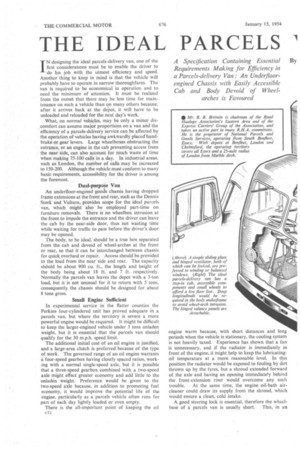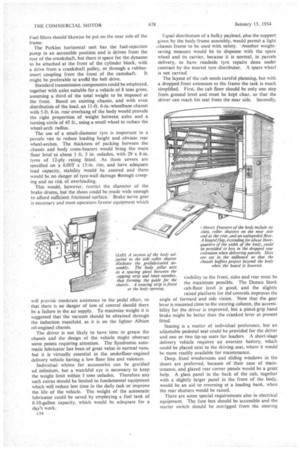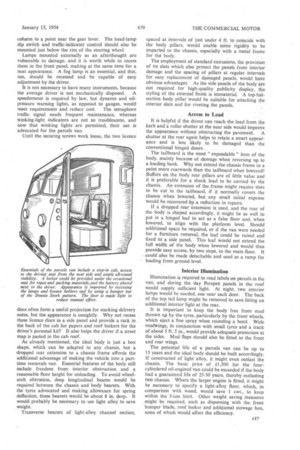THE IDEAL PARCELS HICLE
Page 50

Page 51

Page 52

Page 55

If you've noticed an error in this article please click here to report it so we can fix it.
A Specification Containing Essential By Requirements Making for Efficiency in a Parcels-delivery Van: An Underfloorengined Chassis with Easily Accessible Cab and Body Devoid of Wheel
arches is Favoured :otton, , B. Brittain
IN designing the ideal parcels-delivery van, one of the first considerations must be to enable the driver to do his job with the utmost efficiency and speed. Another thing to keep in mind is that the vehicle will probably have to operate in narrow thoroughfares. The van is required to be economical in operation and to need the minimum of attention. It must be realized from the outset that there may be less time for maintenance on such a vehicle than on many others because, after it arrives back at the depot, it will have to be unloaded and reloaded for the next day's work.
What, on normal vehicles, may be only a minor discomfort can assume major proportions on a van and the efficiency of a parcels-delivery service can be affected by the operation of vehicles having awkwardly placed handbrake or gear levers. Large wheelboxes obstructing the entrance, or an engine in the cab preventing access from the near side, can also account for much waste of time when making 75-100 calls in a day. In industrial areas, such as London, the number of calls may be increased to 150-200. Although the vehicle must conform to many basic requirements, accessibility for the driver is among the foremost.
Dual-purpose Van
An underfloor-engined goods chassis having dropped frame extensions at the front and rear, such as the Dennis Stork and Vulture, provides scope for the ideal parcels van, which might also be employed part-time on furniture removals. There is no wheelbox intrusion at the front to impede the entrance and the driver can leave the cab by the near-side door, thus not wasting time while waiting for traffic to pass before the driver's door may be opened.
The body, to be ideal, should be a true box separated from the cab and devoid of wheel-arches at the front or rear, so that it can be interchanged between chassis for quick overhaul or repair. Access should be provided to the load from the near side and rear. The capacity should be about 900 Cu. ft., the length and height of the body being about 18 ft. and 7 ft. respectively. Normally the parcels van leaves the depot with a 3-ton load, but it is not unusual for it to return with 5 tons, consequently the chassis should be designed for about 8 tons gross.
Small Engine Sufficient
In experimental service in the flatter counties the Perkins four-cylindered unit has proved adequate in a parcels van, but where the territory is severe a more powerful engine would be required. It might be difficult to keep the larger-engined vehicle under 3 tons unladen weight, but it is essential that the parcels van should qualify for the 30 m.p.h. speed limit.
The additional initial cost of an oil engine is justified, and a large-area clutch is preferred because of the type of work. The governed range of an oil engine warrants a four-speed gearbox having closely spaced ratios, working with a normal single-speed axle, but it is possible that a three-speed gearbox combined with a two-speed axle might effect greater economy and add little to the unladen weight. Preference would be given to the two-speed axle because, in addition to promoting fuel economy, it would improve the potential life of the engine, particularly as a parcels vehicle often runs for part of each day lightly loaded or even empty.
There is the all-important point of keeping the oil c112 engine warm because, with short distances and long periods when the vehicle is stationary, the cooling system is not heavily taxed. Experience has shown that a fan is unnecessary, and if the radiator is immediately in front of the engine, it might help to keep the lubricatingoil temperature at a more reasonable level. In this position the radiator would be exposed to fouling by dirt thrown up by the tyres, but a shroud extended forward of the axle and having an opening immediately behind the front-extension riser would overcome any such
trouble. At the same time, the engine oil-bath aircleaner could draw its supply from the shroud, which would ensure a clean, cold intake.
A good steering lock is essential, therefore the wheel base of a parcels van is usually short. This, in an underfloor-engined chassis, would necessitate the power unit being close to the front axle and the crankshaft approximately in line with the final drive to avoid excessive propeller-shaft angularity. An additional purpose is served by this transverse location of the power unit, because the cylinder heads would be outside the frame longitudinal, making for the best possible accessibility.
It is suggested that the heads and injection equipment should be at the near side of the chassis. Mechanical breakdowns on the road are few, but when they occur the driver or fitter now has to work outside the vehicle on the crown of the road, exposed to traffic, if any attention is required to the underfloor power unit, merely because the components are arranged on the off side. Fuel filters should likewise be put on the near side of the frame.
The Perkins horizontal unit has the fuel-injection pump in an accessible position and is driven from the rear of the crankshaft, but there is space for the dynamo to be attached at the front of the cylinder block, with a drive from a crankshaft pulley, or through a rubber insert coupling from the front of the camshaft. It might be preferable to avoild the belt drive.
Standard transmission components could be employed, together with axles suitable for a vehicle of 8 tons gross, assuming a third of the total weight to be imposed at the front. Based on existing chassis, and with even distribution of the load, an 11-ft. 6-in.-wheelbase chassis with 5-ft. 8-in, rear overhang of the body would provide the right proportion of weight between axles and a turning circle of 45 ft., using a small wheel to reduce the wheel-arch radius.
The use of a small-diameter tyre is important in a parcels van to reduce loading height and obviate rear wheel-arches. The thickness of packing between the chassis and body cross-bearers would bring the main floor level to about 3 ft. 5 in. unladen, with 29 x 8-in. tyres of 12-ply rating fitted. As these covers are specified on a 6.00T x 13-in, rim, and have adequate load capacity, stability would be assured and there would be no danger of tyre-wall damage through creeping and no risk of overloading.
This would, however, restrict the diameter of the brake drums, but the shoes could be made wide enough to afford sufficient frictional surface. Brake servo gear is necessary and most operators favour equipment which will provide moderate assistance to the pedal effort, so that there is no danger of loss of control should there be a failure in the air supply. To minimize weight it is suggested that the vacuum should be obtained through the induction manifold, as it is on the lighter Albion oil-engined chassis.
The driver is not likely to have time to grease the chassis and the design of the vehicle might obstruct some points requiring attention. The Syndromic automatic lubricator has been of great value in normal vans, but it is virtually essential in the underfloor-engined delivery vehicle having a low floor line and valences.
Individual whims for accessories can be gratified ad infinitum, but a watchful eye is necessary to keep the weight limit within 3 tons unladen. Therefore any such extras should be limited to fundamental equipment which will reduce lost time in the daily task or improve the life of the vehicle. The weight of the automatic lubricator could be saved by employing a fuel tank of 8-10-gallon capacity, which would be adequate for a day's work.
c.14 Equal distribution of a bulky payload, plus the support given by the body-frame assembly, would permit a light /chassis frame to be used with safety. Another weightsaving measure would be to dispense with the spare wheel and its carrier, because it is normal, in parcels delivery, to have roadside tyre repairs done under contract by the nearest tyre distributor. A spare wheel is not carried.
The layout of the cab needs careful planning, but with a dropped front extension to the frame the task is much simplified. First, the cab floor should be only one step from ground level and must be kept clear, so that the driver can reach his seat from the near side. Secondly,
visibility to the front, sides and rear must be the maximum possible. The Dennis Stork cab-floor level is good, and the slightly raised platform for the controls improves the angle of forward and side vision. Now that the gear lever is mounted close to the steering column, the accessibility for the driver is improved, but a pistol-grip hand brake might be better than the cranked lever at present fitted.
Seating is a matter of individual preference, but an adjustable pedestal seat could be provided for the driver and one or two tip-up seats for loaders. A short-stage delivery vehicle requires an oversize battery, which could be placed next to the driving seat, where it would be more readily available for maintenance.
Deep, fixed windscreens and sliding windows in the doors are preferred, because of their case of maintenance, and glazed rear corner panels would be a great help. A glass panel in the back of the cab, together with a slightly larger panel in the front of the body, would be an aid to reversing at a loading bank, when the rear shutters would be raised.
There are some special requirements also in electrical .equipment. The fuse box should be accessible and the starter switch should be outrigged from the steering column to a point near the gear lever. The head-lamp dip switch and traffic-indicator control should also be mounted just below the rim of the steering wheel.
Lamps mounted externally as an afterthought are vulnerable to damage, and it is worth while to recess them in the front panel, making at the same time for a neat appearance. A fog lamp is an essential, and this, too, should be recessed and be capable of easy adjustment by the driver.
It is not necessary to have many instruments, because the average driver is not mechanically disposed. A speedometer is required by law, but dynamo and oilpressure warning lights, as opposed to gauges, would meet requirements and reduce cost. The semaphore traffic signal needs frequent maintenance, whereas winking-light indicators are not so troublesome, and now that winking lights are permitted, their use is advocated for the parcels van.
Until the securing screws work loose, the two licence discs often form a useful projection for stacking delivery notes, but the appearance is unsightly. Why not recess these licence discs in a side panel and provide a rack in the back of the cab for papers and roof lockers for the driver's personal kit? It also helps the driver if ,a street map is pasted in the cab roof.
As already mentioned, the ideal body is just a box shape, which can be adapted to any chassis, but a dropped rear extension to a chassis frame affords the additional advantage of making the vehicle into a parttime removals van. Essential features of the body still include freedom from interior obstruction and a reasonable floor height for unloading. To avoid wheelarch obtrusion, deep longitudinal beams would be required between the chassis and body bearers. With the tyres advocated and making allowance for spring deflection, these bearers would be about 8 in. deep. It would probably be necessary to use light alloy to save weight.
Transverse bearers of light-alloy channel section, spaced at intervals of just under 4 ,ft. to coincide with the body pillars, would enable" some rigidity to be imparted to the chassis, especially with a metal frame for the body.
The employment of standard extrusions, the provision of tie slats which also protect the panels from interior damage and the spacing of pillars at regular intervals for easy replacement of damaged panels, would have obvious advantages. As the side panels of the body are not required for high-quality publicity display, the styling of the external finish is immaterial. A top-hatsection body pillar would be suitable for attaching the interior slats and for riveting the panels.
Access to Load It is helpful if the driver can reach the load from the kerb and a roller shutter at the near side would improve the appearance without obstructing the pavement A shutter at the rear again helps to retain a smart appearance and is less likely to be damaged than the conventional hinged doors.
The tailboard is the most " expendable" item of the body, mainly because of damage when reversing up to a loading bank. Why not. extend the chassis frame to a point more rearwards than the tailboard when lowered? Buffers on the body rear pillars are of little value and it is preferable for a shock load to be carried by the chassis. An extension of the frame might require slots to be cut in the tailboard, if it normally covers the chassis when lowered, but any small initial expense would be recovered by a reduction in repairs.
If a dropped rear extension is used, and the rear of the body is shaped accordingly, it might be as well to put in a hinged leaf to act as a false floor and, when lowered, to align with the platform level, Should additional space be required, or if the van were needed for a furniture removal, the leaf could be raised and fixed to a side panel. This leaf would not extend the full width of the body when lowered and would thus provide easy access, by two steps, to the main floor. It could also be made detachable and used as a ramp for loading from ground level.
Interior Illumination Illumination is required to read labels on parcels in the van, and during the day Perspex panels in the roof would supply sufficient light. At night, two interior lamps would he needed, one near each door. The back of the top tail lamp might be removed to save fitting an additional interior fight at the rear.
It is important to keep the body free from mud thrown up by the tyres, particularly by the front wheels, which eject a fine spray when rounding a bend. Wide mudwings, in conjunction with small tyres and a track of about 5 ft. 5 in., would provide adequate protection at the sides. Mud flaps should also be fitted to the front and rear wings.
The potential life of a parcels van can be up to 15 years and the ideal body should be built accordingly. If constructed of light alloy, it might even outlast the chassis. The basic price of £1,500 for the fourcylindered oil-engined van could be exceeded if the body had a guaranteed Iffe of 25-30 years, thereby outlasting two chassis. Where the larger engine is fitted, it might be necessary to specify a light-alloy floor, which, in comparison with wood, would save 1 cwt., to keep within the 3-ton limit. Other weight saving measures _ might be required, such as dispensing with the front bumper blade, roof locker and additional stowage box, none of which would affect the efficiency.




































































































